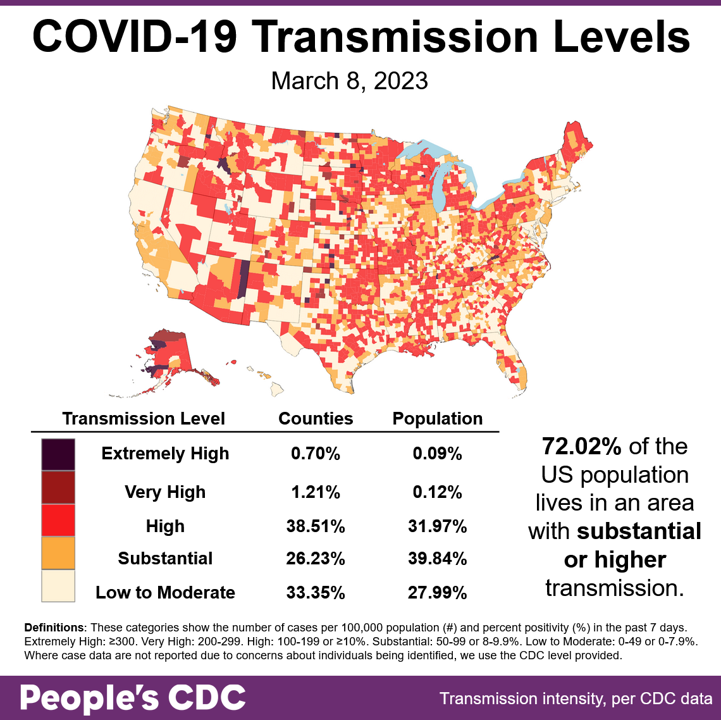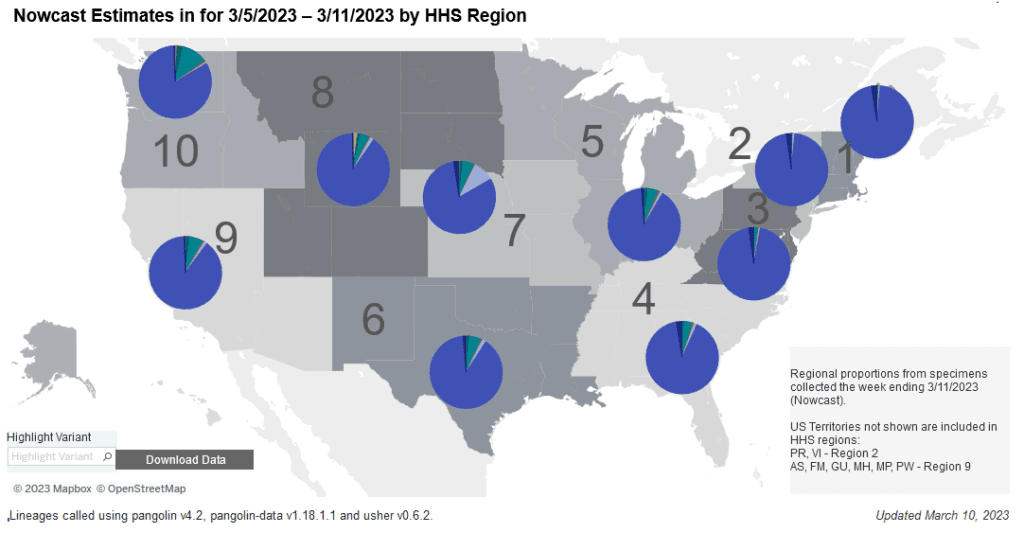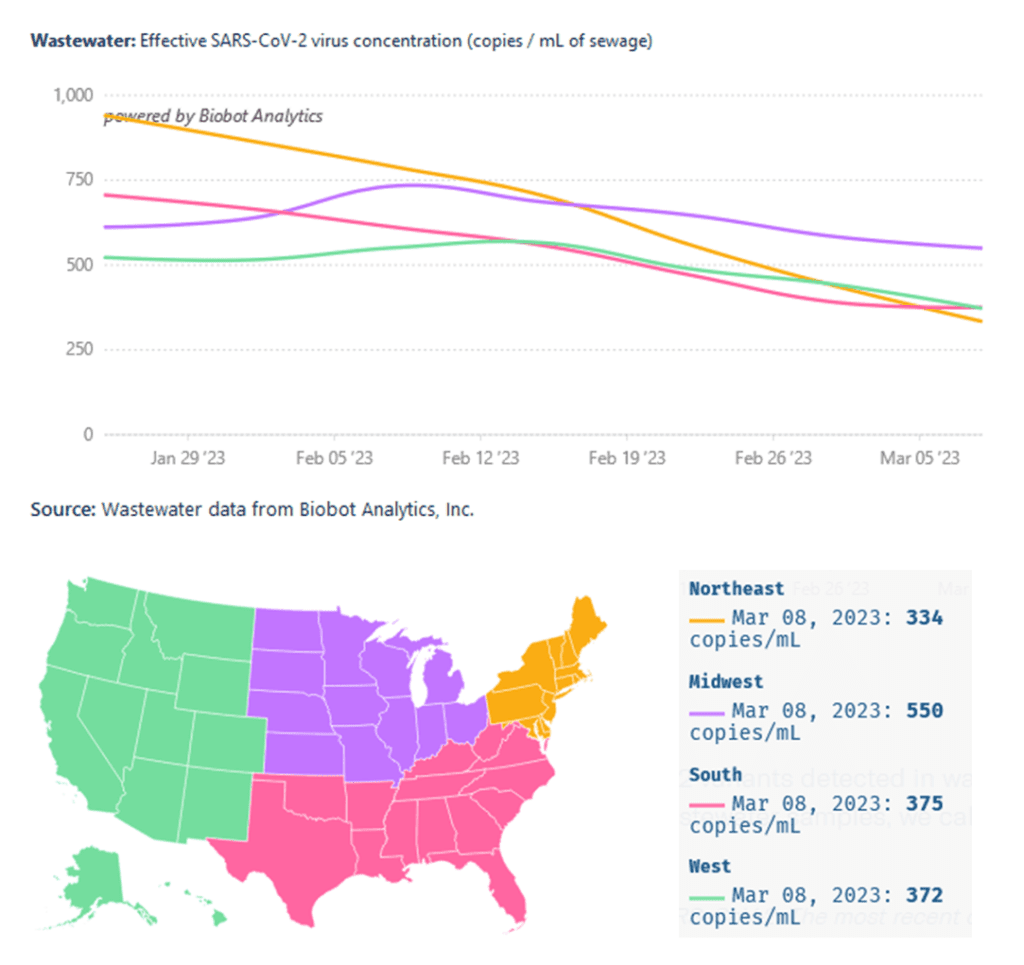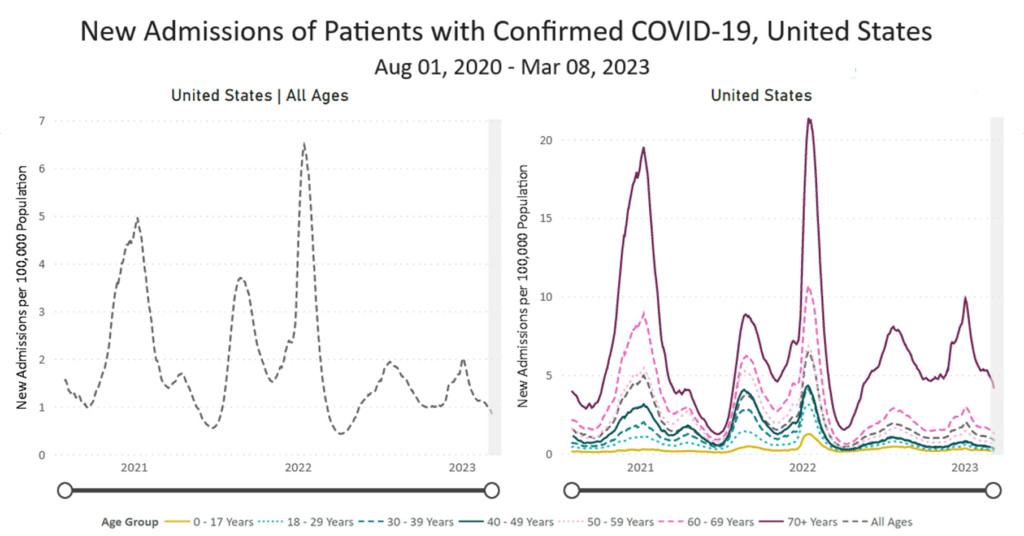The Weather: A significant 72.02% of the population continues to live in areas with substantial or higher transmission. While this is a meaningful drop from last week, this is still as much as 3 in 4 people in the United States. Data processing delays this week also make case results from Florida, Utah, and Washington appear lower than they truly are.

Wins: There is a bright spot in the darkness that is the removal of universal masking in California Healthcare. San Francisco will continue to require healthcare workers to be masked and vaccinated to protect patients from forced COVID exposure.
While this indeed is a win, we should continue to apply pressure so we can reverse California’s harmful decision and ensure that San Francisco does not rescind these guidelines in the future.
On Variants: This week, Kraken (XBB.1.5) makes up 89.5% of cases, which is about the same as the 89.6% of cases reported in last week’s Weather Report. The amount of Kraken did still increase from last week however, as the NowCast from last week has since been updated to be 87%, slightly lower than initially thought.

We have now reached a point where no matter what HHS region of the US you are in, at least 4 in 5 people in your region who catch COVID are catching Kraken. In the case of the Northeast, it’s almost 5 out of 5.

Wastewater Monitoring: Wastewater levels on average appear to continue to slowly decrease or plateau across the country, though levels of COVID viral load overall continue to remain high, indicating community spread.

However, if you zoom in to specific counties, you’ll find more variation in how wastewater levels are trending. For example, wastewater levels in San Jose have risen to high levels in recent weeks, and they’re currently increasing in parts of Los Angeles. This tells us that the national trend is not the end-all-be-all–please check your county’s wastewater levels too!
Hospitalizations: Hospitalizations for confirmed COVID cases remain high at national rates of almost 5 per 100,000 for ages 70+ and almost 1 per 100,000 for all ages.

Deaths: The week of March 8, 2023, 1,862 people died of COVID nationally. At least 1,119,762 people have died from COVID in the US. Deaths for the past week may be even larger due to incomplete data from processing delays for Utah, Washington, and Florida.
Long COVID: Long COVID issues are continuing to slowly but solidly enter mainstream discourse. A recent CNN article interviews people who have Long COVID, asking about and reporting on their expressed needs. This is critical advice that anyone trying to help friends or employees who have Long COVID should know.
Biological: Scientists continue working hard to discover new COVID treatments. For example, they have tentatively discovered a new way to potentially restrict COVID infection in the body: by blocking specific complexes called mSWI/SNF from enabling viral RNA to multiply. This discovery, currently in very early laboratory studies, may hold promise to fight even strains resistant to current drugs like Remdesivir.
Forecast: A major continuing problem is that our indoor air is now filled with COVID and flu viruses. This is why it is heartening to see that several countries are moving to improve indoor air quality standards. The movement for freedom to breathe clean air must succeed if we are to have a livable society free of long-term illness.
Take Action: Activists recently confronted Moderna CEO Stephane Bancel asking him to share lifesaving mRNA vaccine technology with the developing world. Rather than help people who lack access to vaccines and treatments, he continues to corruptly shackle them to sickness through prohibitive costs and artificial scarcity.
We will not be silenced: share the video and sign the petition to demand Moderna share the science for global vaccine access and freedom to good health!
Our medical facilities are one of the last safe havens left where universal masking remains, protecting us from Long COVID during routine appointments. This is why it is especially malicious that many states are removing universal masking in healthcare settings.
Join Seattle Still Cares in fighting to retain universal masking in healthcare and prisons in Washington, and join this petition and call campaign to do the same for New Jersey.
Join a West Coast coordinated action to #KeepMasksInHealthCare in CA, OR, WA. Register for a live zoom phone banking event on Tuesday, March 14 12 PT https://tinyurl.com/WCCPhonebank and together tell policymakers masks protect vulnerable people in healthcare and other high risk settings.
Thank you so much for reading. We’ll be taking a well-deserved spring break next week so after this week’s report you can catch us again on March 27th!
Notes: 1) The numbers in this report were current as of 3/11. The CDC updates data frequently as it receives refreshed information. Today’s numbers may be slightly different from the data here. 2) Check out the links throughout & see our website for more! https://bej.gbh.mybluehost.me.